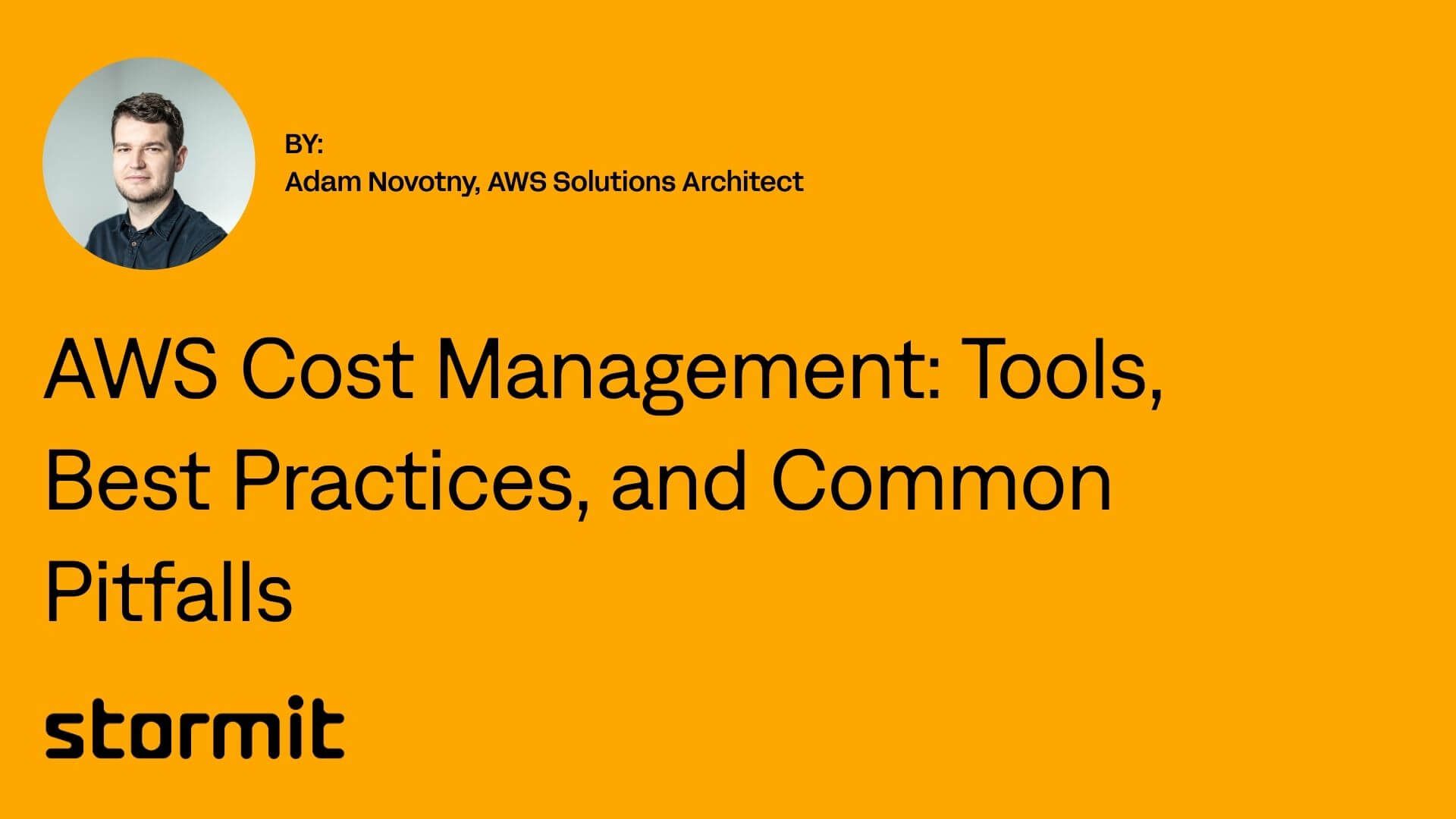AWS Cost Management: Tools, Best Practices, and Common Pitfalls
This guide to AWS cost management covers the most effective tools, proven best practices, and common pitfalls that lead to wasted spend – helping you identify gaps, improve usage, and take control of your AWS costs. In this article, you will learn:
- What Is AWS Cost Management?
- AWS Cost Management Tools You Need
- AWS Billing Dashboard
- AWS Cost Explorer
- AWS Budgets
- Cost and Usage Reports (CUR)
- Cost Anomaly Detection
- Best Practices for Implementing AWS Cost Management
- Hidden Mistakes That Undermine AWS Cloud Cost Management
Cloud cost optimization is no longer a new initiative. Most teams have accepted it as a priority, responding to rising waste, growing cloud complexity, and pressure to establish financial accountability. But while action is being taken, the results often don’t reflect the effort – largely due to fragmented or incomplete AWS cloud cost monitoring and management practices.
That’s because AWS cloud cost management is rarely approached as a complete system. Efforts are scattered across tagging policies, budgeting alerts, usage tweaks, and commitment purchases, each handled in isolation, with no shared strategy tying them together. You end up with activity, not clarity.
What’s missing is a structured approach that defines what to measure, how to respond, and which AWS Cost Management tools and practices actually move the needle for your environment.
This blog offers a focused look at AWS cost management, outlining essential tools, strategic best practices, and common gaps that quietly drive costs off track.
What Is AWS Cost Management?
AWS cost management is the discipline of monitoring, analyzing, and optimizing cloud spend within AWS environments. It includes tracking usage across services, setting budgets, allocating costs by team or project, and applying pricing models or automation to control expenses. The goal is not just to reduce costs, but to improve financial accountability without limiting engineering flexibility.
The need for a structured cost management approach has grown significantly in recent years. As companies scale in the cloud, they’re operating in fast-moving environments where infrastructure changes daily, new workloads are deployed, services are spun up and down, and pricing structures shift based on region, instance type, or commitment level.
This flexibility is powerful for technical teams, but creates blind spots for finance. Engineering can provision resources in minutes, while finance teams are left reconciling unexpected charges weeks later. Without real-time insights or proper tagging and allocation, cost accountability becomes fragmented. One team’s experiment becomes another team’s budget overrun.
That’s why AWS cost management needs to be approached as a continuous, cross-functional process. It’s not a one-time setup, but an ongoing effort to align teams, surface the right data, and turn cost awareness into informed decision-making.
AWS Cost Management Tools You Need
AWS offers a suite of native AWS cost monitoring tools and management services built into your account. These tools can be highly effective when configured properly, giving your teams the visibility, control, and insights needed to stay aligned on budgets and spending decisions.
Here are the primary AWS cost management tools that can be helpful:
AWS Billing Dashboard
The AWS Billing Dashboard is your central hub for viewing high-level cost and billing data across your AWS environment. It provides a visual summary of current charges, month-to-date spending, and historical billing trends. While it doesn’t offer deep analysis, it’s the first place most teams go when checking their AWS costs.
Key features include:
- Month-to-date spend: See current spending against your billing cycle.
- Service-level overview: View costs broken down by AWS service.
- Linked account filtering: Drill down by account in consolidated billing setups.
- Invoice and payment history: Access past billing documents and payment records.
- Credits and refunds: Track promotional credits and refunds applied to your account.
You need this tool for a quick, accessible summary of your AWS spending, ideal for finance and leadership teams who want a reliable snapshot without diving into detailed reports.
AWS Cost Explorer
AWS Cost Explorer is the primary tool for analyzing and visualizing your AWS spending. It provides detailed reports that help you understand how costs evolve over time, what services or accounts are driving them, and where optimization opportunities may exist. Unlike the Billing Dashboard, Cost Explorer allows you to drill deeper into usage trends and filter costs using multiple dimensions.
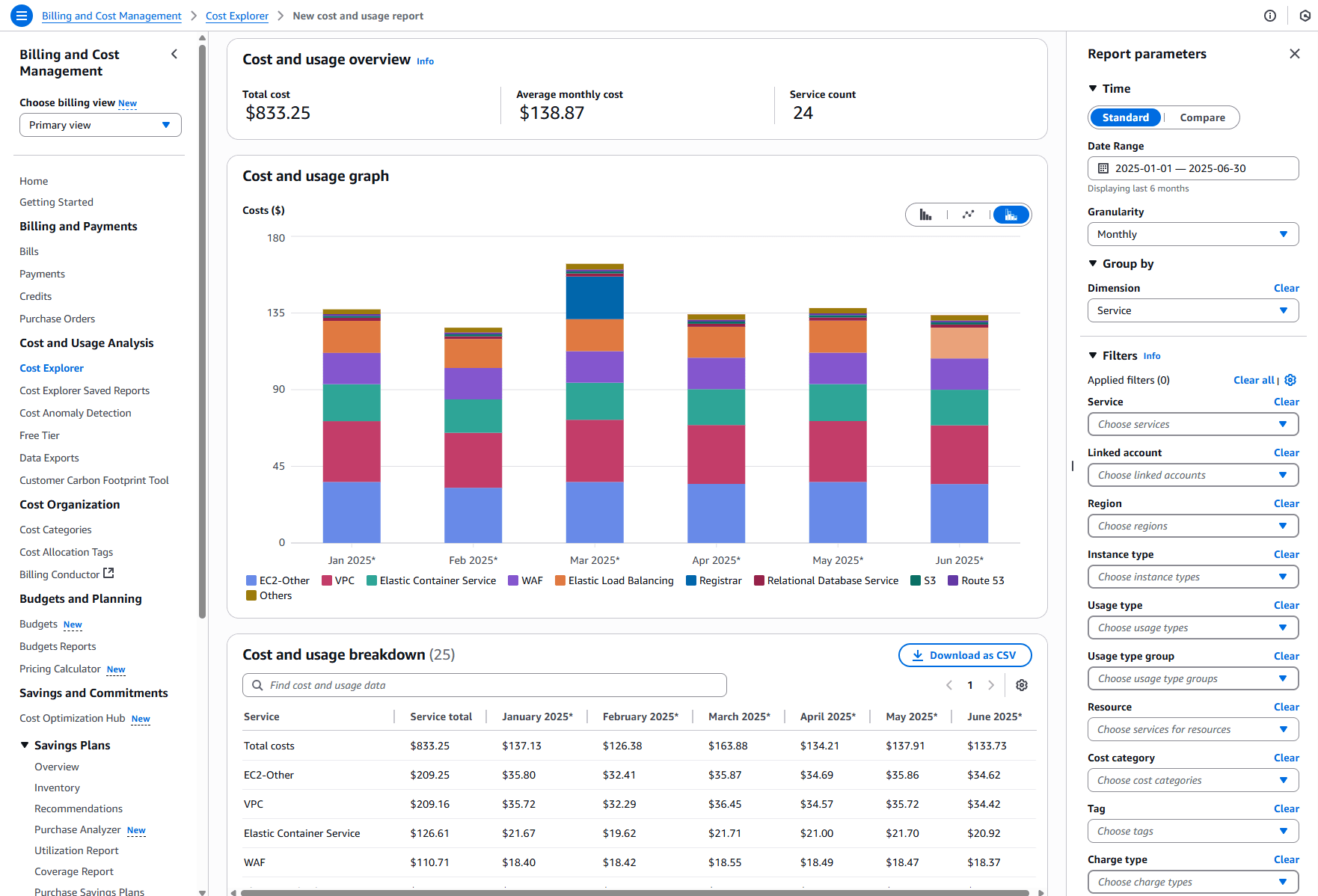
This tool is especially useful for organizations with complex environments including multiple accounts, tags, projects, or business units, where understanding the full picture requires more than just top-line numbers.
Key features include:
- Time-based visualizations: View daily, monthly, or custom range spend trends.
- Filtering and grouping: Break down costs by service, linked account, region, or tag.
- Forecasting: Estimate future costs based on past usage patterns.
- RI/SP reporting: Monitor Reserved Instance and Savings Plan utilization and coverage.
- Export options: Download reports for offline analysis or cross-team sharing.
You need this tool to turn your billing data into actionable insights, making it easier to identify inefficiencies, track progress, and align cost trends with operational decisions.
AWS Budgets
AWS Budgets allows you to set custom thresholds for your cloud costs, usage, or reservation coverage and receive alerts when you approach or exceed them. It adds a layer of proactive control by turning financial guardrails into automated notifications, helping you catch potential issues before they escalate.
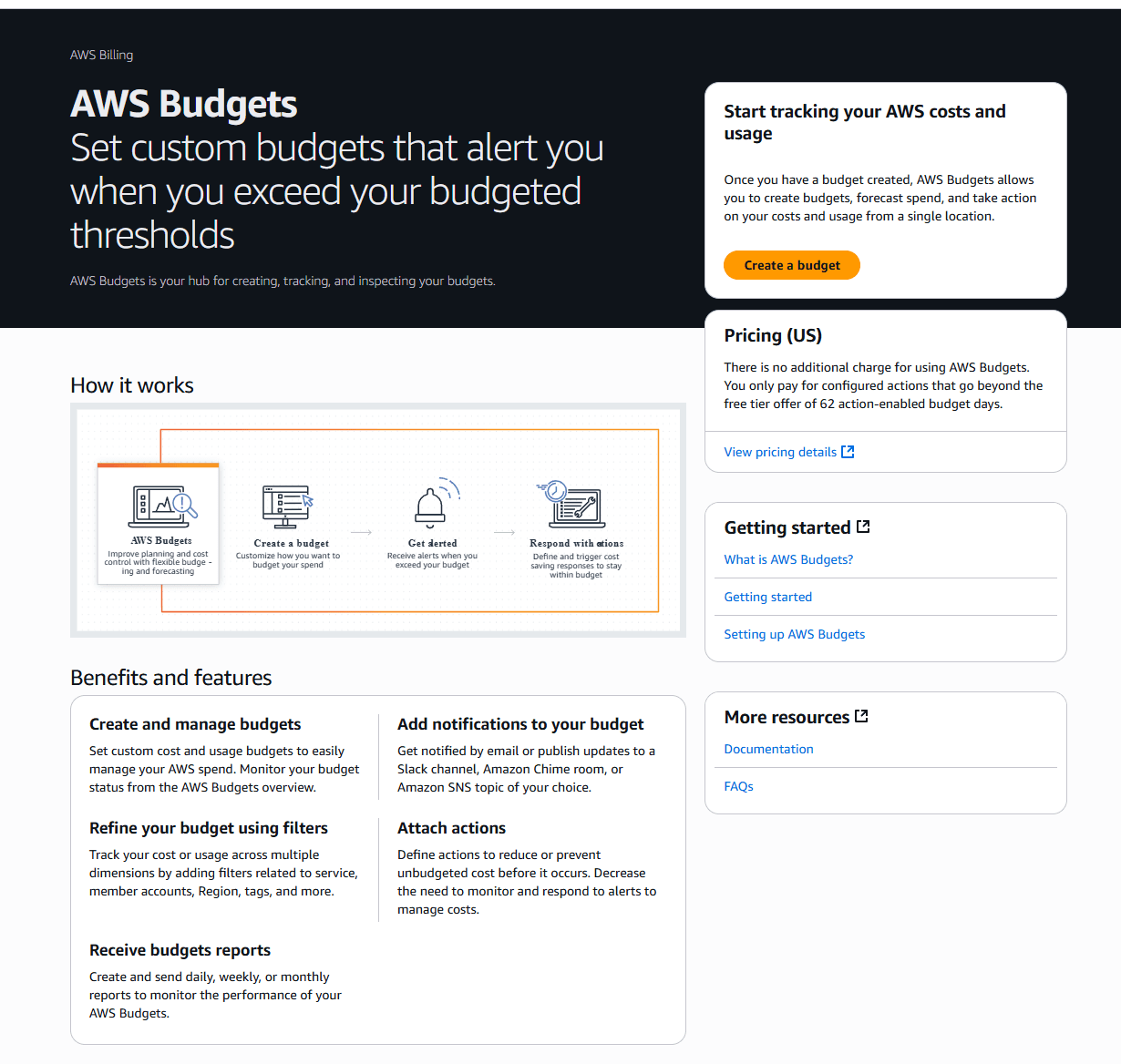
Key features include:
- Custom budget thresholds: Set limits based on cost, usage, or discount program metrics.
- Alerts and notifications: Get notified when actual or forecasted spend exceeds defined thresholds.
- Granular filtering: Create budgets by service, account, region, or tag.
- Budget actions: Automate responses like stopping resources or limiting access.
- Multi-budget tracking: Monitor multiple budgets from a centralized view.
You need this tool to stay ahead of cost overruns and bring accountability into daily operations, helping teams act on budget drift before it becomes a problem.
Cost and Usage Reports (CUR)
AWS Cost and Usage Reports (CUR) provide the most comprehensive and granular view of your AWS billing data. Delivered as CSV or Parquet files to an Amazon S3 bucket, CUR gives you line-item details for every usage event, enabling highly customized reporting and in-depth cost analysis. CUR includes data points such as usage quantity, rate, resource IDs, account IDs, tags, and any discounts or credits applied.
Key features include:
- Line-item billing detail: Access raw, service-level usage and cost data.
- S3 delivery: Store CUR data in your own environment for full control.
- Athena/QuickSight integration: Query the data or visualize it using familiar tools.
- Custom report intervals: Choose daily or hourly report granularity.
- Tag and account mapping: Track usage by teams, environments, or applications.
You need this tool if you require deep billing transparency, custom financial reporting, or automated workflows tied to AWS spend.
Cost Anomaly Detection
AWS Cost Anomaly Detection is a machine learning-powered service that continuously monitors your cloud spending to identify unusual spikes or unexpected cost behavior. You can create monitors for specific services, linked accounts, or organizational units, and set up subscribers who receive alerts via email or Amazon SNS.
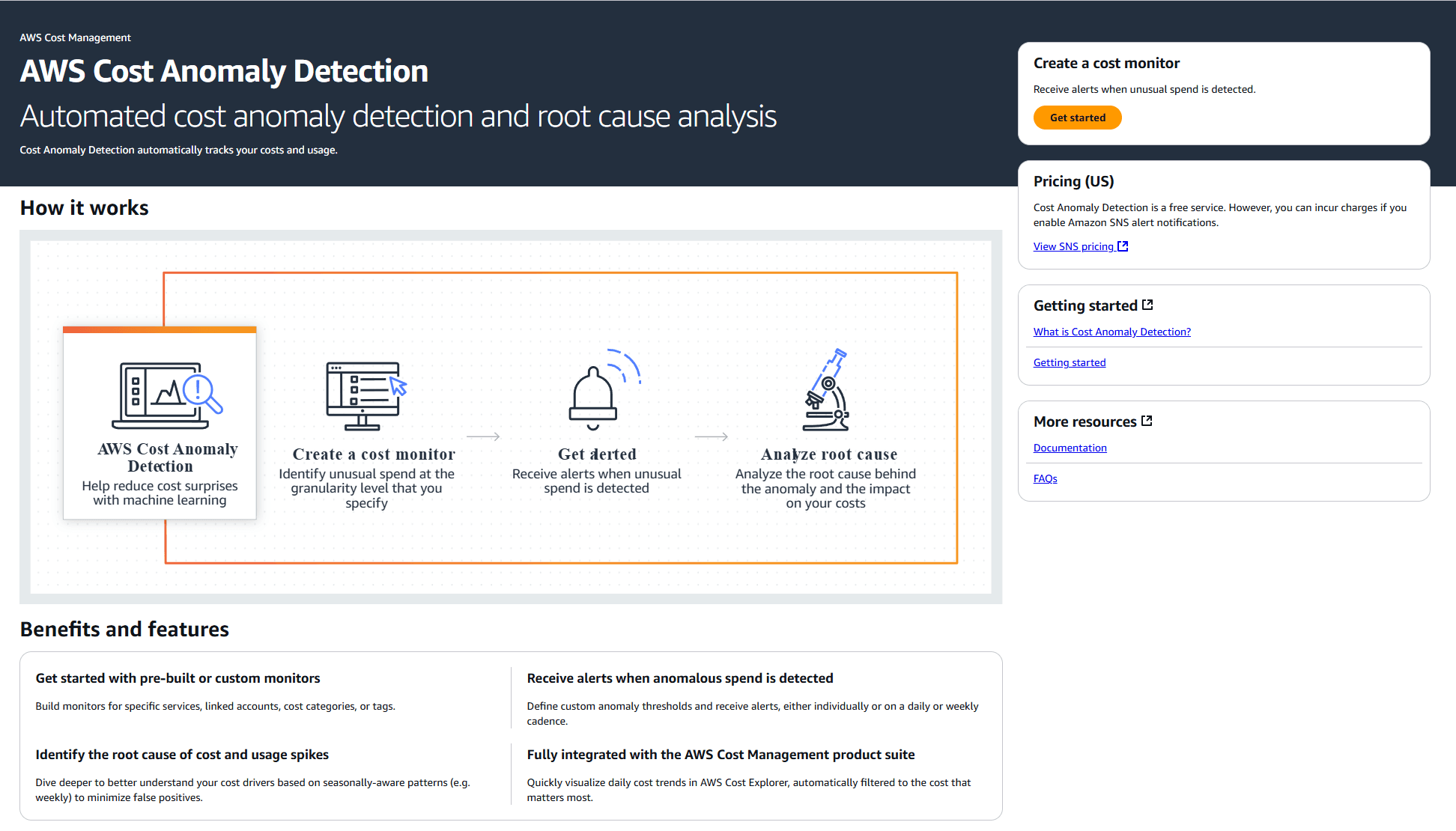
Image Source: AWS Blog
Key features include:
- Automated anomaly detection: Identifies cost spikes based on historical usage trends.
- Custom monitors: Track specific services, accounts, or linked accounts.
- Real-time alerts: Notify users immediately via email or SNS.
- Low configuration overhead: Works with minimal setup or manual tuning.
- Historical anomaly reports: Review past anomalies for pattern analysis.
You need this tool to catch cost issues before they snowball, especially in large or fast-moving environments where traditional alerts might not scale or respond quickly enough.
Unsure if you’re getting the most out of your AWS cost management tools? Schedule a free consultation to uncover missed opportunities.
Best Practices for Implementing AWS Cost Management
Even the best tools will fall short without a strong underlying structure. These AWS Cost Management best practices help teams move beyond isolated efforts and create a consistent, collaborative approach to managing AWS costs.
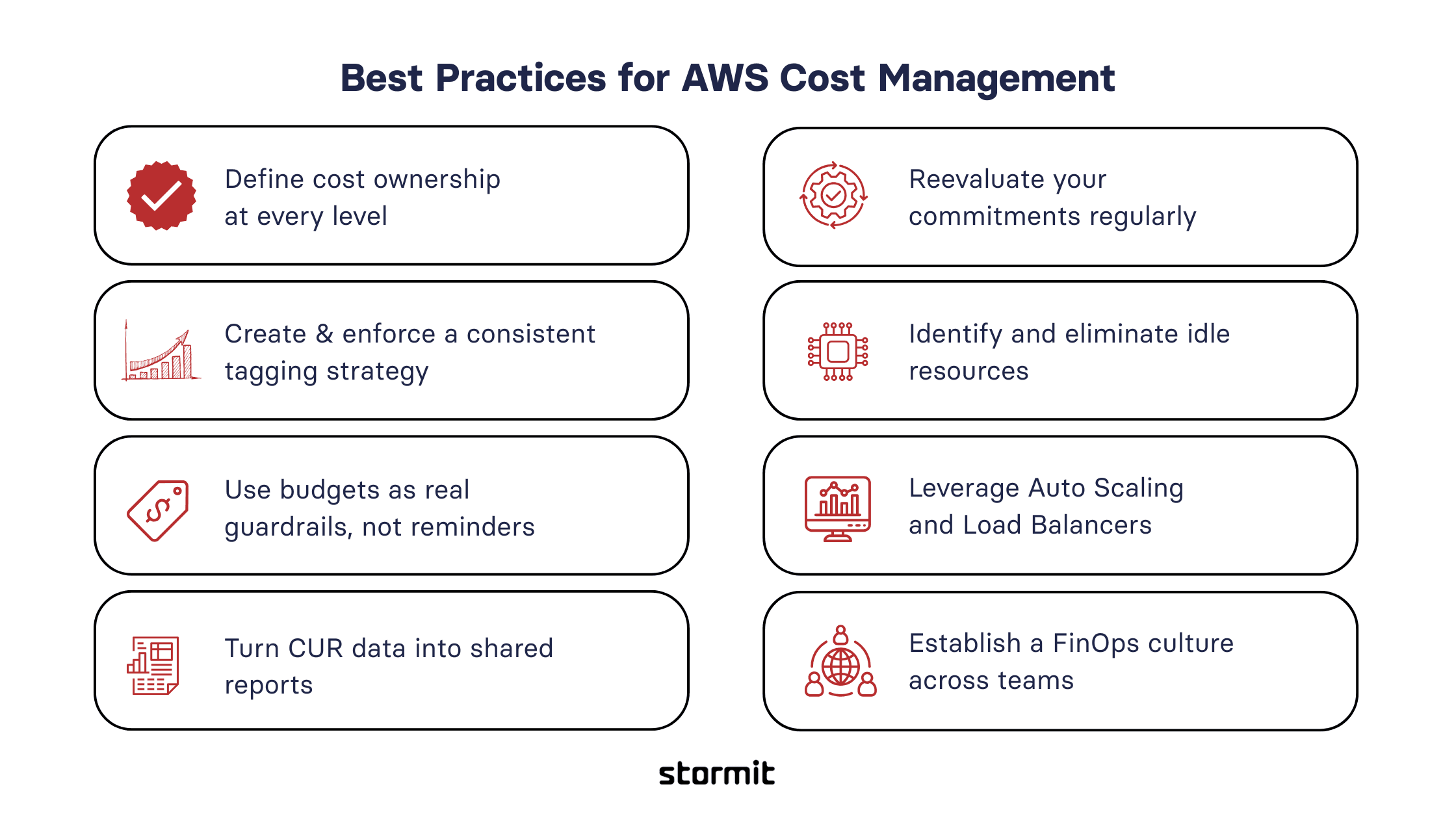
1. Define cost ownership at every level
Assigning clear ownership over cloud costs is essential. Each business unit, product team, or environment should be accountable for its own usage. Use tags, linked accounts, and cost categories to map spending back to the right owners. When people know what they are responsible for, optimization becomes a shared habit instead of a reactive fix.
2. Create and enforce a consistent tagging strategy
Without standardized tagging, cost data quickly loses meaning. Define a minimal set of required tags such as team, environment, project, and cost center. Make these tags mandatory through service control policies or automation scripts. Clean tags are the foundation for accurate reporting, allocation, and anomaly detection.
3. Use budgets as real guardrails, not reminders
AWS Budgets are most effective when they reflect real limits. Set budgets for both actual and forecasted spend. Break them down by service, account, or project so teams know where they stand. Configure alerts to trigger early in the cycle, giving people time to take corrective actions rather than just acknowledge the problem.
4. Turn CUR data into shared reports
Cost and Usage Reports give you everything you need, but only if the data is usable. Set up integrations with Amazon Athena or QuickSight to build dashboards for finance, engineering, and leadership. This ensures all teams are looking at the same numbers and making decisions based on the same facts.
5. Reevaluate your commitments regularly
Savings Plans and Reserved Instances are not set-and-forget tools. Usage patterns shift, environments grow, and what made sense last quarter may not be optimal today. Review commitment coverage and utilization every quarter and if possible, every month too. Adjust purchases based on current trends to avoid waste or undercoverage.
6. Identify and eliminate idle resources
Unattached volumes, underused instances, and forgotten test environments can silently accumulate cost. Regularly audit your environment to identify these resources, and set up alerts or automation to decommission them when no longer needed.
7. Leverage Auto Scaling and Load Balancers
Auto Scaling groups and Elastic Load Balancing help match resource capacity to demand in real time. This reduces idle time during off-peak hours and prevents resource exhaustion during spikes. Implement scaling policies that align with actual usage patterns to optimize cost while maintaining performance and availability.
8. /Establish a FinOps culture across teams
Finance, engineering, and product teams must collaborate with shared visibility and common goals. Establish regular cost reviews, build shared dashboards, and align KPIs that reflect both technical efficiency and business value. A strong FinOps culture helps turn cost optimization into a daily practice rather than a periodic clean-up.
Hidden Mistakes That Undermine AWS Cloud Cost Management
On the surface, many organizations appear to be managing cloud costs well. Tools are active, dashboards exist, and reports are shared. But underneath that, structural gaps quietly erode efficiency. These mistakes are harder to spot but often have the biggest impact.
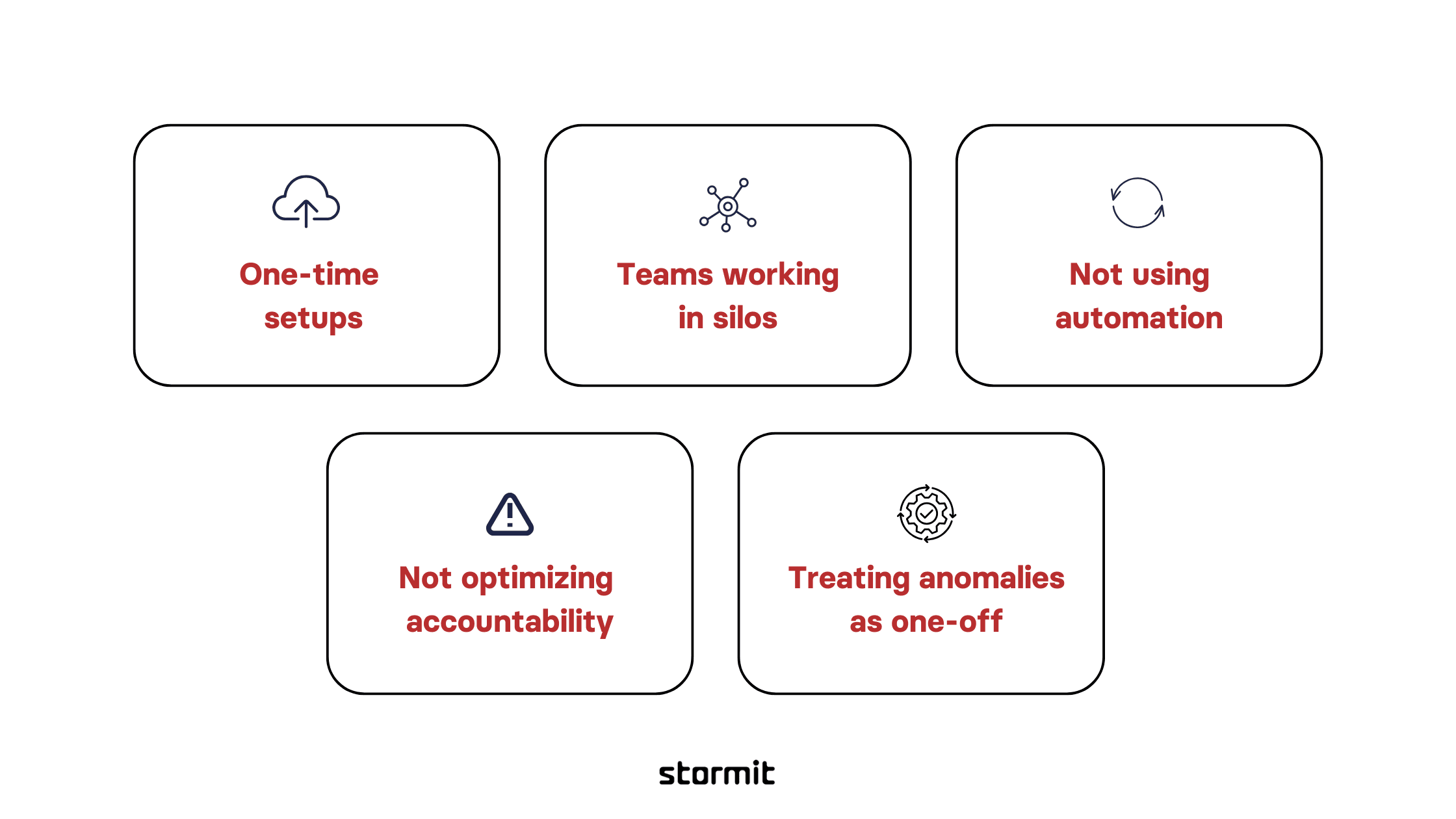
1. Assuming one-time setups will scale
Budgets, tags, and account mappings are often treated as a checklist item. Once configured, they are rarely revisited. But AWS environments change constantly. New teams get onboarded, workloads evolve, and pricing models shift. Without revisiting and adjusting your configurations frequently, your AWS cost controls lose relevance and slowly drift away from actual usage.
2. Finance and engineering work in silos
Cost data is often reviewed by finance and procurement, while the infrastructure decisions are made entirely by engineering. This disconnect leads to delays, confusion, and reactive fixes. Cost management needs joint ownership. That means shared dashboards, common terminology, and regular reviews where both sides understand the impact of decisions being made.
3. Not using automation in daily cost controls
Many teams still rely on manual cost reviews or occasional tagging audits. This is not scalable. Without automation, there is no real-time enforcement or response. Simple automations like idle resource shutdowns, tagging enforcement, budget-triggered actions, or anomaly-based alerts can save time, prevent waste, and help teams operate with confidence.
4. Optimizing for savings but not accountability
It is possible to reduce overall spend while losing sight of where it came from. Some teams end up over-optimized, while others remain untouched. Without proper cost allocation and accountability, optimization becomes lopsided and disconnected from business goals.
5. Treating anomalies as one-off incidents
Flagging unexpected charges is helpful, but if the same anomalies return each month, you are not solving the problem. True AWS cost control comes from fixing the root causes behind those spikes, whether that means restructuring workloads, updating scaling policies, or refining ownership boundaries.
To tackle these mistakes effectively, you need more than just tool access. You need AWS cost management expertise, people who have worked through these exact challenges across different environments.
Not sure if your setup is doing enough? In a free 30-minute session, we’ll walk through your current tools and highlight gaps that could be costing you.
When You Should Consider an External Review?
Even with the right AWS cloud cost management tools and intentions, internal teams often do not have the time or bandwidth to perform deep, strategic cost reviews. Day-to-day operations take priority, and while budgets and alerts may be in place, they are rarely followed up with structured analysis or cross-team alignment.
This is where AWS cost management services provided by external experts can make a measurable impact.
- If you are consistently going over budget, dealing with unpredictable cost spikes, or struggling with fragmented AWS cloud cost monitoring, those are signs that your internal setup may have blind spots.
- Many teams using AWS Budgets, Cost Explorer, and tagging frameworks still miss a significant percentage of optimization opportunities. These are often hidden in simply misconfigured AWS services, misaligned account structures, inconsistent tags, unallocated shared resources, or usage patterns that no longer reflect how workloads are actually running.
An external review brings in fresh perspective and proven benchmarks. Whether through a structured free AWS Well-Architected Review or a focused cost audit, this can help you uncover optimizations that internal reviews often overlook.
If you are unsure where the gaps lie in AWS cloud cost management, start with a free 30-minute session with Stormit experts. We bring cross-functional experience across finance, engineering, and cloud operations to identify inefficiencies, expose blind spots, and help you turn fragmented efforts into a clear, actionable cost strategy.
